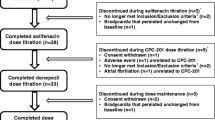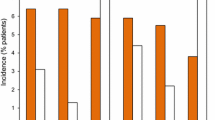Abstract
Oral donepezil and rivastigmine are two commonly used cholinesterase inhibitors (ChEIs) used in Alzheimer’s disease (AD). The rivastigmine transdermal patch formulation has high tolerability profile, allowing patients to achieve optimal therapeutic doses and providing potential advantages over oral ChEIs. This is a 6-month, multicentre, observational efficacy and tolerability study of switching from oral ChEIs to rivastigmine patch in AD patients who failed to show benefit from previous treatment. The reasons of the switch were: (1) lack/loss of benefit from previous oral ChEI treatment; (2) tolerability problems. The primary outcome was cognitive changes measured with the mini–mental state examination (MMSE) test. Secondary outcomes were modifications of functional independence and behavioral disturbances and occurrence of adverse events (AEs) after switching. 174 patients, over 180 patients screened, entered the study (lack/loss of efficacy: 57 %, tolerability problems: 33 %, both reasons: 10 %). 6 months after switching 56 % of patients stabilized or increased the MMSE score respect to baseline. The only predictor of this outcome was the response at 3 months. In the group with lack/loss of response to oral ChEI, the decline of the MMSE score changed from −3.4 ± 2.5 points in the 6 months before switching to −0.5 ± 3.2 in the 6 months after the switch (p < 0.001). There were no significant changes in the IADL or NPI scores. Drug discontinuation rate was 20 %, due to AEs (18 %) and lack of compliance (2 %). Switching from an unsuccessful oral ChEI therapy to rivastigmine patch is effective and safe in more than half of the switched patients after a 6-month period.



Similar content being viewed by others
References
Cummings JR (2004) Alzheimer’s disease. N Engl J Med 351:56–67
Gauthier S, Emre M, Farlow MR et al (2003) Strategies for continued successful treatment of Alzheimer’s disease: switching cholinesterase inhibitors. Curr Med Res Opin 19:707–714
O’Brien JT, Burns A, BAP Dementia Consensus Group (2011) Clinical practice with anti-dementia drugs: a revised (second) consensus statement from the British Association for Psychopharmacology. J Psychopharmacol 25:997–1019
Cummings JL (2003) Use of cholinesterase inhibitors in clinical practice: evidence-based recommendations. Am Geriatr Psychiatry 11:131–145
Farlow MR, Cummings J (2007) Effective pharmacologic management of Alzheimer’s disease. Am J Med 120:388–397
Winblad B, Grossberg G, Frölich L et al (2007) IDEAL: a 6-month, double-blind, placebo-controlled study of the first skin patch for Alzheimer disease. Neurology 69:S14–S22
Lawton MP, Brody EM (1969) Assessment of older people: self-maintaining and instrumental activities of daily living. Gerontologist 9:179–186
Cummings JL, Mega M, Gray K et al (1994) Neuropsychiatric Inventory. Neurology 44:2308–2314
Raschetti R, Maggini M, Sorrentino GC et al (2005) A cohort study of effectiveness of acetylcholinesterase inhibitors in Alzheimer’s disease. Eur J Clin Pharmacol 61:361–368
Sadowsky CH, Dengiz A, Olin JT et al (2009) Switching from donepezil tablets to rivastigmine transdermal patch in Alzheimer’s disease. Am J Alzheimers Dis Other Demen 24:267–275
Han HJ, Lee JJ, Park SU et al (2011) Efficacy and safety of switching from oral cholinesterase inhibitors to the rivastigmine transdermal patch in patients with probable Alzheimer’s disease. J Clin Neurol 7:137–142
Auriacombe S, Pere J-J, Loria-Kanza Y et al (2002) Efficacy and safety of rivastigmine in patients with Alzheimer’s disease who failed to benefit from treatment with donepezil. Curr Med Res Opin 18:129–138
Wattmo C, Wallin AK, Londos E et al (2011) Predictors of long-term cognitive outcome in Alzheimer’s disease. Alzheimers Res Ther 3:23
Spalletta G, Caltagirone C, Padovani A et al (2014) Cognitive and affective changes in mild to moderate Alzheimer’s disease patients undergoing switch of cholinesterase inhibitors: a 6-month observational study. PLoS One 9:e89216
Pilotto A, Franceschi M, D’Onofrio G et al (2009) Effect of a CYP2D6 polymorphism on the efficacy of donepezil in patients with Alzheimer disease. Neurology 73:761–767
Nordberg A, Darreh-Shori T, Peskind E et al (2009) Different cholinesterase inhibitor effects on CSF cholinesterases in Alzheimer patients. Curr Alzheimer Res 6:4–14
Salmon DP, Thal LJ, Butters N et al (1990) Longitudinal evaluation of dementia of the Alzheimer type: a comparison of 3 standardized mental status examinations. Neurology 40:1225–1230
Acknowledgments
The study was supported by the Department of Neurosciences, University of Padova, and by all the Memory Clinics participating to the study.
Conflict of interest
The authors have no financial conflict of interest.
Author information
Authors and Affiliations
Consortia
Corresponding author
Additional information
The all participants to the SWITCH study group are listed in the Appendix.
Appendix: list of participants of the SWITCH study and affiliations
Appendix: list of participants of the SWITCH study and affiliations
Ada Della Libera: Geriatric Division, Motta di Livenza Hospital, Motta di Livenza (VE), Italy.
Michela Marcon: Neurology Division, S. Bortolo Hospital, Vicenza (VI), Italy.
Bruno Costa: Neurology Division, Mater Salutis Hospital, Legnago (VR), Italy.
Enrico Vitale, Marino Formilan: Department of Geriatric and Rehabilitation Medicine, Noale-Dolo (VE) Italy.
Alessio Dalla Libera: Neurology Division, Hospital of Thiene, Thiene (VI), Italy.
Emilia Zanetti: Geriatric Division, Conegliano Hospital, Conegliano Veneto (TV), Italy.
Maria Cristina Mantovan: Neurology Clinic, Angel Hospital, Mestre (VE), Italy.
Paolo Spagnolli: Geriatric Division, Sacro Cuore - Don Calabria Hospital, Negrar (VR), Italy.
Anna Ceccon: Geriatric Division, Cittadella Hospital, Cittadella (PD), Italy.
Evelina Bianchi: Geriatric Division, S. Bortolo Hospital, Vicenza (VI), Italy.
Sara Pompanin: Department of Neurosciences SNPSRR, University of Padova, Padova (PD), Italy.
Rights and permissions
About this article
Cite this article
Cagnin, A., Cester, A., Costa, B. et al. Effectiveness of switching to the rivastigmine transdermal patch from oral cholinesterase inhibitors: a naturalistic prospective study in Alzheimer’s disease. Neurol Sci 36, 457–463 (2015). https://doi.org/10.1007/s10072-014-2002-3
Received:
Accepted:
Published:
Issue Date:
DOI: https://doi.org/10.1007/s10072-014-2002-3




